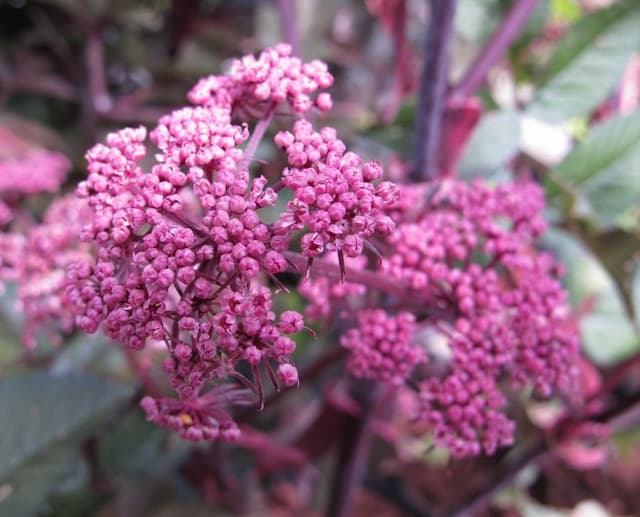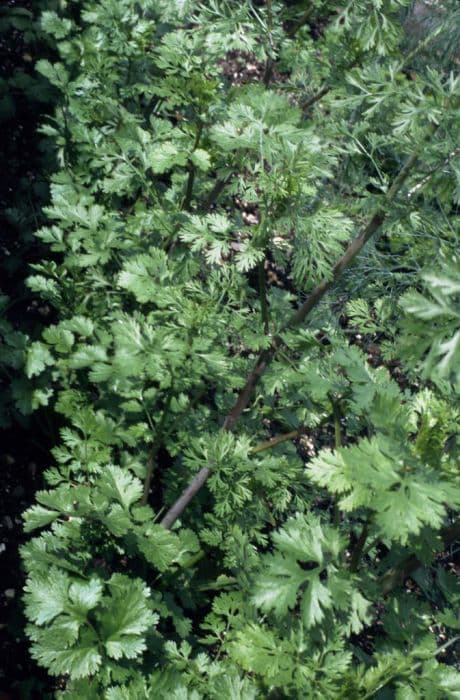Apium graveolens var. rapaceum 'Prinz'

ABOUT
The plant in question is commonly known as 'Prinz' celeriac. It exhibits a dense cluster of green, finely textured leaves that emerge from its base. The leaves have a similar appearance to that of celery, with their characteristic ribbed and upright stalks. They could vary in shades from lighter to deeper green. Underneath this leafy surface, the plant forms a bulbous, knotty root which is the edible part commonly used in culinary applications. The root itself can have a rough, textured surface, often covered in small root hairs and may present a hue ranging from pale beige to a brownish tint. The flesh inside the root is creamy-white and firm, providing a crisp texture when raw. The entire plant exudes a strong, fresh aroma that can be described as earthy and slightly sweet with a hint of nuttiness, characteristic of celeriac varieties.
About this plant
 Names
NamesFamily
Apiaceae
Synonyms
Celeriac, Turnip-Rooted Celery, Root Celery, Knob Celery, German Celery, Celery Root
Common names
Apium graveolens var. rapaceum 'Prinz'
 Toxicity
ToxicityTo humans
Apium graveolens var. rapaceum 'Prinz' is commonly known as celeriac. Celeriac is not toxic to humans and is widely consumed as a root vegetable. It is important, however, to note that some individuals may have allergic reactions to celeriac, especially those who have a known allergy to celery or other plants in the Apiaceae family. Typically, these allergic reactions can include oral allergy syndrome, which may result in itching or swelling of the mouth, lips, and throat after consuming the plant. In very rare cases, more severe allergic reactions could occur, potentially leading to anaphylaxis, which is a life-threatening condition that requires immediate medical attention. Otherwise, celeriac is safe for human consumption when prepared properly.
To pets
Apium graveolens var. rapaceum 'Prinz', commonly known as celeriac, is generally not considered toxic to pets. However, it belongs to the same family as celery, which contains psoralens and potentially toxic essential oils. While celeriac is less commonly associated with toxicity in pets compared to other members of the Apiaceae family, ingestion in large quantities could theoretically cause mild gastrointestinal upset, such as vomiting or diarrhea. Pets with a history of food sensitivity or allergies may also exhibit allergic reactions after consuming celeriac. It is advisable to introduce any new foods, including celeriac, to pets in small amounts to monitor for any adverse effects. If a pet is known to have a specific allergy to vegetables in the Apiaceae family, it is best to avoid feeding them celeriac. If any concerning symptoms occur after ingestion, consult with a veterinarian.
 Characteristics
CharacteristicsLife cycle
Biennials
Foliage type
Deciduous
Color of leaves
Green
Flower color
Varies
Height
1-2 feet (30-60 cm)
Spread
1-2 feet (30-60 cm)
Plant type
Herb
Hardiness zones
5
Native area
Mediterranean
Benefits
 General Benefits
General Benefits- Nutritional Value: The plant is a good source of essential nutrients such as vitamins and minerals.
- Culinary Uses: Commonly known as celeriac, it is used in a variety of recipes for its unique flavor and texture.
- Soil Health: Like other root vegetables, celeriac helps in soil aeration and structure when grown.
- Pollinator Attraction: Flowers of the celeriac can attract beneficial insects like bees to the garden.
- Companion Planting: Celeriac can be grown with other plants as it is known to have beneficial companion planting properties.
- Low-Calorie Option: Celeriac is low in calories making it a good option for weight-conscious diets.
- Versatility: Celeriac can be eaten raw or cooked, providing a versatile ingredient in the kitchen.
- Herbal Use: The leaves can be used as herbs to add flavor to dishes, although this is not the primary use of celeriac.
 Medical Properties
Medical Properties- Diuretic: Apium graveolens var. rapaceum, commonly known as celeriac, may have diuretic effects that help increase urine production and reduce water retention.
- Antioxidant: Celeriac is rich in antioxidants, which can help protect cells from oxidative damage.
- Anti-inflammatory: The plant may contain compounds with anti-inflammatory properties that can help reduce inflammation in the body.
- Digestive Aid: It is traditionally thought to aid in digestion and help with digestive disorders.
 Air-purifying Qualities
Air-purifying QualitiesThis plant is not specifically known for air purifying qualities.
 Other Uses
Other Uses- Celeriac 'Prinz' is used as a natural deodorizer for refrigerators and coolers. Its ability to absorb odors helps to keep these spaces smelling fresh without the use of artificial chemicals.
- Due to its dense root structure, celeriac 'Prinz' can be utilized in floral arrangements as a water-retentive base, providing hydration and support to cut flowers.
- The peels from celeriac 'Prinz' can be dried and added to potpourri mixes for a hint of earthy fragrance in homes and sachets.
- Finely chopped or grated celeriac 'Prinz' may serve as a biodegradable confetti in garden celebrations or compostable party decor.
- Celeriac 'Prinz' is used in companion planting to deter certain garden pests naturally, as some insects dislike its strong aroma and taste.
- The rough texture of dried celeriac 'Prinz' skin can be used as a natural abrasive for cleaning dirty pots and pans.
- When planted, celeriac 'Prinz' can help in soil stabilization and erosion control because of its robust root system.
- In arts and crafts, thin slices of celeriac 'Prinz' can be carved into stamps for eco-friendly printing or stenciling projects.
- Celeriac 'Prinz' might also be used in natural dye-making processes, as the roots can provide subtle color variances to fabrics or yarns.
- Leftover celeriac 'Prinz' scraps are often used as a component in vermiculture, as worms can easily process and benefit from these nutrient-rich plant parts.
Interesting Facts
 Feng Shui
Feng ShuiThe Celeriac is not used in Feng Shui practice.
 Zodiac Sign Compitability
Zodiac Sign CompitabilityThe Celeriac is not used in astrology practice.
 Plant Symbolism
Plant Symbolism- Fertility - Apium graveolens var. rapaceum, commonly known as Celeriac or 'Prinz,' has been historically associated with fertility and reproduction, possibly due to its rich nutritional profile that supports overall vitality and health.
- Strength and Endurance - Celeriac's hardy nature and ability to grow in difficult conditions symbolizes physical and mental strength, as well as the endurance to withstand challenges.
- Hidden Potential - The root of the Celeriac plant grows underground and is not immediately visible, representing the hidden talents or potential that one may possess.
- Grounding - As a root vegetable, Celeriac is associated with grounding energy, reminding us to stay connected with the earth and our foundation.
 Water
WaterCeleriac, commonly known as root celery, requires consistent moisture to develop its characteristic bulbous root without becoming woody. Water the plant deeply once or twice a week, providing approximately 1 to 1.5 gallons per square foot every seven days, depending on weather conditions. During hot, dry periods, increase the frequency to ensure the soil remains moist but not waterlogged. It's important to avoid overhead watering to reduce the risk of leaf diseases; instead, use a soaker hose or drip irrigation at the base of the plant.
 Light
LightCeleriac thrives best in full sun conditions, meaning it should receive at least 6 to 8 hours of direct sunlight daily. An ideal spot would be an open area in the garden that is not shaded by trees or buildings during the peak sun hours. If full sun is not possible, it can tolerate partial shade, but this may affect the size and quality of the root.
 Temperature
TemperatureThe celeriac plant fares well in cooler climates and can tolerate temperatures as low as 40°F without harm. The ideal growing temperature for celeriac is between 60°F and 70°F. It should not be subjected to temperatures above 75°F for extended periods, as high heat can impede growth and affect the flavor of the root.
 Pruning
PruningRegular pruning is not required for celeriac's growth. However, removal of yellow or damaged leaves can promote better air circulation and reduce the risk of disease. Prune away any flower stalks that may appear to direct the plant's energy into developing the root rather than seeding. The best time for this light maintenance is during the cooler parts of the day, either early morning or late afternoon.
 Cleaning
CleaningAs needed
 Soil
SoilCeleriac 'Prinz' thrives in fertile, well-drained soil with plenty of organic matter; a mix of garden soil, compost, and perlite is ideal. The best soil pH for this plant is between 6.0 and 7.0.
 Repotting
RepottingCeleriac 'Prinz' typically does not require repotting as it is usually grown as an annual; however, ensure it's started with ample room for root growth.
 Humidity & Misting
Humidity & MistingCeleriac 'Prinz' prefers moderate humidity levels but is adaptable to garden conditions without particular humidity requirements.
 Suitable locations
Suitable locationsIndoor
Use large pots, fertile soil, ample water for celeriac 'Prinz'.
Outdoor
Plant in rich soil, full sun, keep moist for celeriac 'Prinz'.
Hardiness zone
3-9 USDA
 Life cycle
Life cycleThe life of celeriac, also known as Apium graveolens var. rapaceum 'Prinz', begins with seed germination, typically taking place in early spring or late winter under proper conditions of moisture and temperature. After germination, the seedling stage follows, characterized by the growth of primary leaves and the establishment of a small root system. As the plant matures, it enters the vegetative growth stage where it develops a robust leafy canopy and begins to form its distinctive enlarged hypocotyl, which is the edible part of celeriac. Flowering and seed production occur after a period of vernalization; the plant develops inflorescences that attract pollinators for seed set during summer. Once seeds mature, they can be harvested and stored for the next planting cycle or left to self-sow. Finally, the plant senesces and dies back, completing its life cycle, typically after harvest in late autumn or early winter.
 Propogation
PropogationPropogation time
Spring to Summer
Apium graveolens var. rapaceum 'Prinz', commonly known as celeriac 'Prinz', is typically propagated by seed. The ideal time to sow celeriac seeds is in early spring, about 10 to 12 weeks before the last expected frost date. The seeds are sown in a seed-starting mix, lightly covered with soil, and kept at a temperature of 70 to 75 degrees Fahrenheit (21 to 24 degrees Celsius). They require consistent moisture to germinate, which usually takes 14 to 21 days. After the seedlings have developed their first set of true leaves and are large enough to handle, they are transplanted to individual pots or cells to grow until they are robust enough to be moved to their final positions in the garden after all danger of frost has passed.









